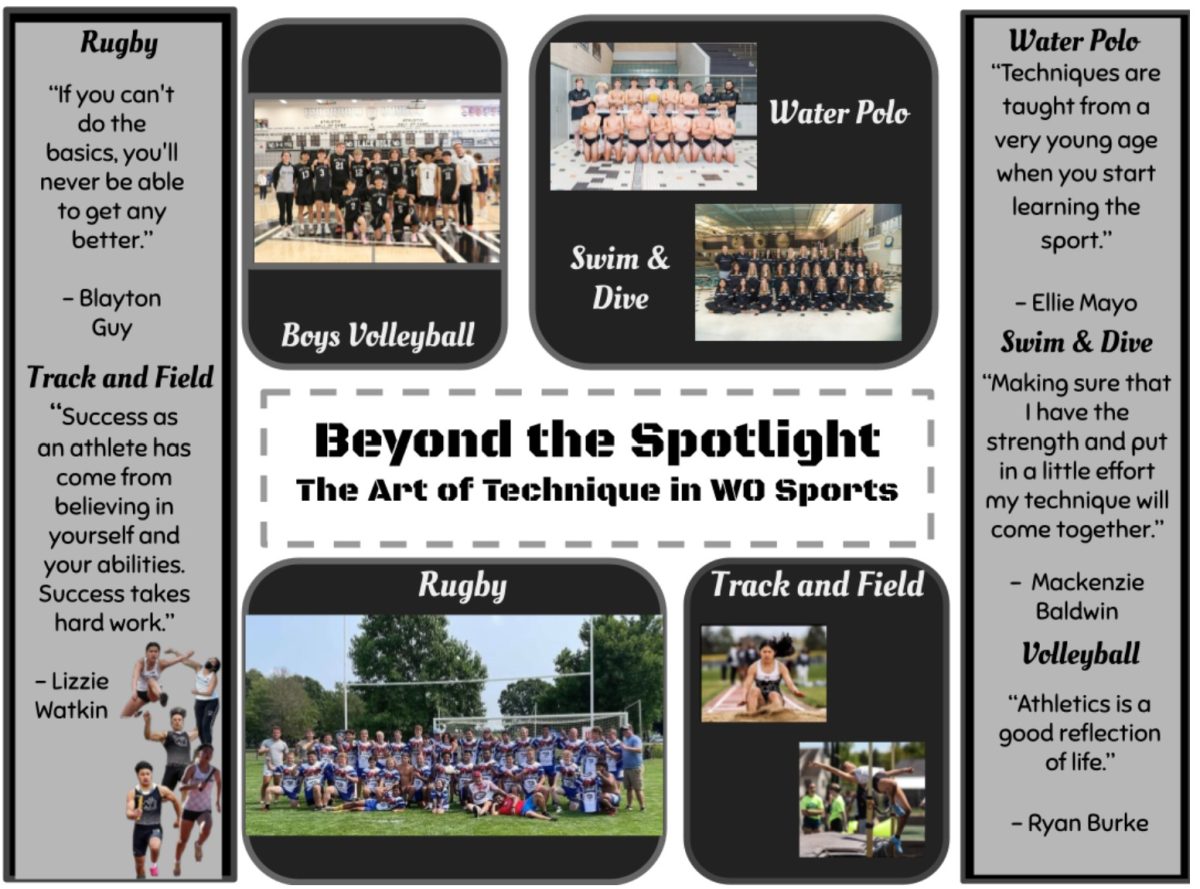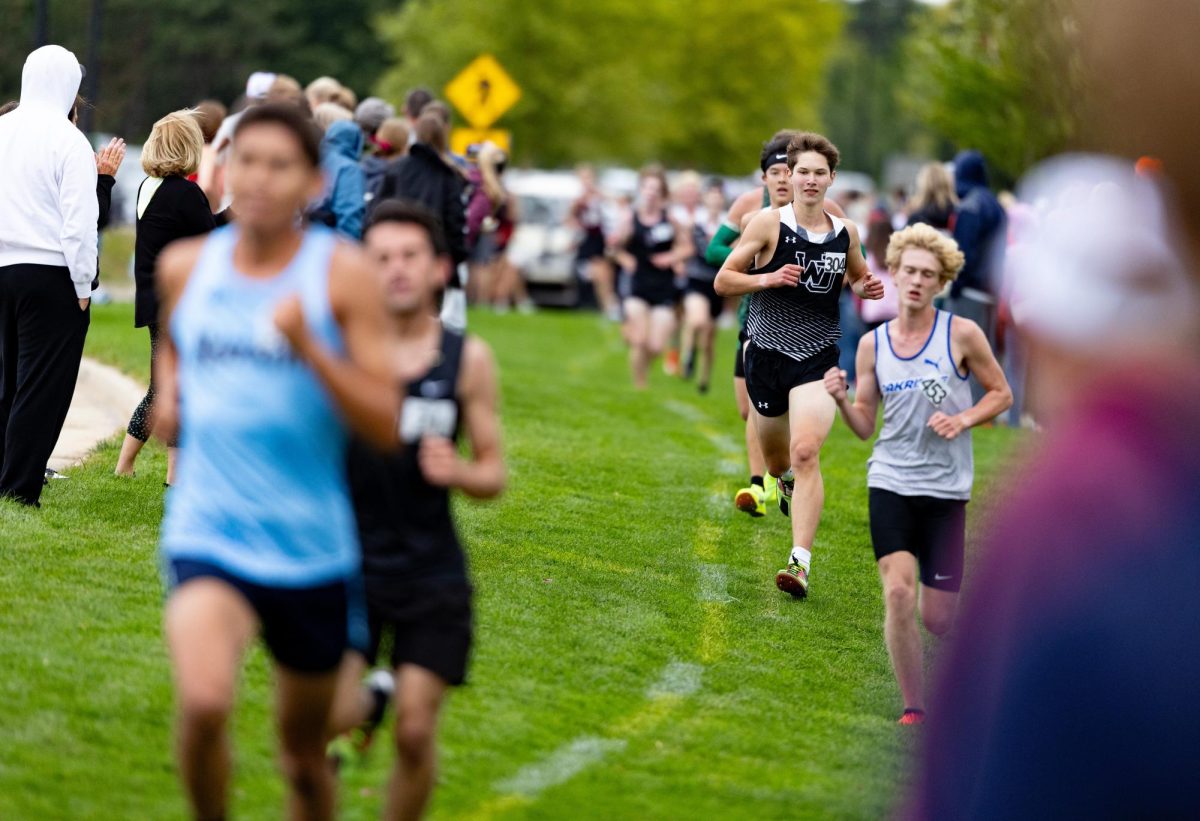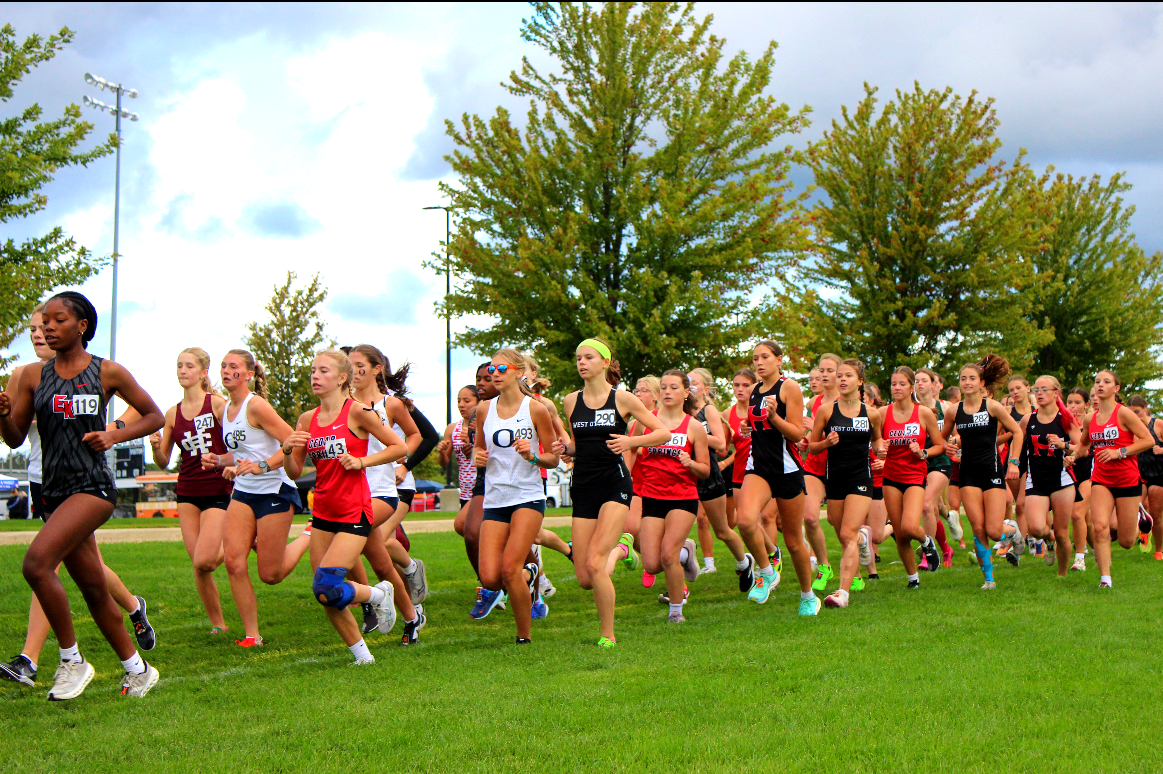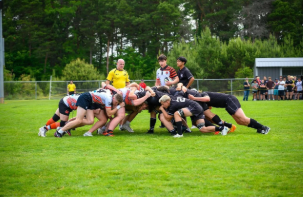Amidst the cheers for football and basketball stars, there exists a quieter realm of athletic excellence. Popular sports at West Ottawa like football, basketball, and soccer may dominate headlines, but numerous ‘niche’ sports showcase equally remarkable skill and technique. From volleyball’s explosive jumps, the streamlined efficiency of swimmers, the tactical endurance of rugby, and the devoted force of field events in track, these athletes also master unique skills that require time, effort, and determination. These overlooked champions demonstrate that greatness is not exclusively found on the grandest platforms.
Swim and Dive: Fluidity and Precision
Poised at the board’s edge, Jr. Eli McNeely’s toes curl over the weathered surface as his chest rises with controlled breaths, each muscle coiled with anticipation. McNeely said, “For different dives, I have to know exactly where my body is in the air to be able to do the dive. Another helpful aspect is the hurdle, getting a good approach and hurdle allows me to get higher off the board.” Diving has various distinct body positions. For example, ‘straight’ is when a diver’s body is completely straight without bending at the hips or knees. ‘Tuck’ involves coiling one’s body tightly with one’s hands on their lower legs. ‘Pike’ is like a tuck, but the body is bent at the hips but not bending the knees. Then ‘free,’ this body position is only for twisting dives. During a competition, the body positions are referred to by the letters A, B, C, and D.
On the other hand, swim athletes launch off the board into the water to begin the race. Swimmers must keep a staggered start with their dominant leg in front, grabbing the front of the board with their big toe. Swimmers need to pull on the block with their hands as they take off. When swimming, they’re taught to keep their heads locked in position, staring at the bottom of the pool to help reduce drag. The only exception would be an occasional breath after a certain number of strokes.
In the MHSAA Division 1 State Championship at the Michael H. Jones Natatorium, Sr. Makenzie Baldwin surged towards the end of her 100-yard backstroke winning 1st place with a time of 56.06. Swimming is all about finding a way to maximize the efficiency of each stroke. State champ and school record holder Baldwin said, “What I focus on during backstroke is my arm pull underwater. Not only is the reach of my stroke important but the down pull is a technique that makes me stronger and faster since the race is about how fast I can pull a large amount of water.” When freestyling, one’s arm needs to make a 45-degree angle as their fingertips touch the water. Once the swimmer extends their arm fully in the water, they need to perform the ‘catch’. After full extension, they drop their fingertips toward the bottom and pull through with their hand and forearm. The increased surface area from one’s forearm helps to maximize each stroke.
Water Polo: Dynamic and Aggressive
The water polo player’s right arm cradles the yellow ball just above the water’s chaos, muscles tensed and ready to unleash a lightning-quick shot past the goalkeeper’s outstretched arms. Water polo is a combination of sports like soccer, hockey, and basketball. Water polo uses a soccer-sized yellow ball, and an athlete is only allowed one hand to hold or pass the ball at a time.
Similar to basketball, water polo offers various ways to move the ball through the water. One can move the ball in water polo in a couple of ways. Sr. Ellie Mayo said, “There’s normal dribbling (ball between your arms as you’re swimming), ball in hand (palm the ball in one hand as you are swimming), and fingertip dribbling (using fingers and palm to push the ball forward). Each way is used in different situations to help advance in the game.” Water polo athletes like Mayo are required to be able to tread water for extended periods while simultaneously completing passes and shots.
“You can shoot it normally into the goal or backhand it to catch them off guard,” said Jr. Noah Williams. The main shots of water polo are high and low, skips, and back-end shots. High shots are aimed at the upper portion of the goal using their legs to push up out of the water and rotating their torso as they snap their wrist to throw. Low shots are aimed at the lower part of the goal however they shoot with their body slightly hunched over or using a crouch stance to help direct the ball downward. Skip shot involves the ball being deliberately bounced off the water before reaching the goal and the key to getting a good bounce is by their wrists. By snapping the ball when shooting, they can create the proper backspin and velocity needed. The back-end shot is taken when their back is facing the goal, twisting their torso quickly using their wrist flick and legs to help propel the shot.
Boys Volleyball: Exhilarating and Team-Oriented
Volleyball isn’t merely a girls’ sport – it’s a game where both genders thrive, with remarkable teams representing the school on the court. Although the girls’ volleyball team has gained acclaim for its impressive performances and competitive attitude, it’s essential to acknowledge the boys’ team as well.
Instructor and boys Varsity volleyball coach Ryan Burke said, “Volleyball is a highly skilled sport, if you are not playing a ton it is hard to get better.” With dedicated athletes who only play boys’ volleyball and commitment to the sport, the boys volleyball team showcase their passion for the sport each season. Various volleyball techniques include serving, passing, hitting, or blocking.
Sr. Kaden Phetthongdy spins the ball slowly in his palms at the service line, his serve ritual is a moment of focused calm before the storm. For serves, there is a float serve and a spike/jump serve. Before any volleyball player serves, they always have a routine. Phetthongdy said, “When it comes to serving, one of the most important things to have is a routine. This allows you to serve and be confident behind the line every single time.”
In order to attack, a volleyball athlete starts their approach with their non-dominant leg back. A right-handed athlete’s footwork sequence would consist of steps that follow the left-right-left pattern. A left-handed athlete would execute the sequence in the inverse. The distance between each step goes as follows, medium-long-short. The angles of foot placement are also important in the matter of spiking. The first foot is completely straight, the second step is at a 30-45 degree angle, third would be a 45-90 degree angle. Sr. Kendrick Servis said, “When attacking the volleyball I snap my wrist downward to produce the most power and spin on the ball, and when jumping I pump my arms up as I jump to maximize my jump.”
Rugby: Art of Controlled Chaos
In West Ottawa’s grass fields, Sr. Blayton Guy cuts through the opposing defense as if they were made of silk. Rugby is not just a game of brute force, it contains technical sophistication such as passing variations, strategic positioning, tackling techniques, and various defensive techniques. To play and understand rugby, one must first nail down simple techniques like passing, tackling, and catching. Guy, who has played in Washington D.C. and Nashville said, “Your tackle technique is the most important thing, in my opinion. For safety and just overall player status.” The technique for tackling is based on planting one’s feet as close as possible to the ball carrier and hitting low with the shoulder on the same side.
There are four different types of passes a rugby player can perform. For example, there is a basic pass, spin pass, pop pass, and scrumhalf/half-back pass. The basic pass is often executed by a flick of the hands to pass the ball. A rugby athlete holds the ball with their fingers spread across the seams. The pop pass is the easiest to pass and catch, and it is used in short range. The pop pass hand position is accomplished by placing their hands on either side of the bottom half of the ball. Rugby players position their hands with their fingertips reaching skyward and palms extended forward.
However, the key to catch lies in a subtle adjustment: the passing hand drops slightly, about an inch below the receiving hand. For example, when getting a left-directed pass, the right hand becomes the dominant force, its palm lowered just enough to create the launching point. In order to pass, hand placement is important to create spin. When placing one’s hand on the bottom of the ball, one must first have the thumb of their hand facing up and fingers spread and place it on the lower back of the ball. The athlete’s hand is placed atop the ball with their thumb along the side of the ball, while their fingers round the bottom. The top hand guides where the ball is going, but also pinches the ball at the same time to aid spin.
Track and Field: Explosive and Disciplined
In West Ottawa’s track and field, there are many events one person can participate in. The most widely known events are the track events, which include relays, sprints, and hurdles. However, many field events go on during the season that are not as recognized. Events such as shot put, discus throw, and long jump are some of the many field events.
In shot put, competitors must hurl a heavy metal ball with a weight of 4lb. or 12lb. which depends on the athlete’s gender. To properly perform the shot put, there are many intricate details and techniques one must know. Firstly, how a shut put is held is important. Athletes place the ball at the base of their fingers, keeping them slightly apart, and then they use their thumb to prevent the shot from rolling off. In preparation for their throw, they place the ball on their neck and keep their elbow high. Finally, when the time comes to launch the shot put, the athlete must grind their foot into the ground to create a load-up into the quad, leading into a full torque-induced hip rotation that allows the athlete to create the momentum to be explosive in their release.
Discuss is an event that also requires throwing, it is an equally challenging and physically demanding sport similar to the shot put. In the discus, competitors must throw a heavy disc as far as possible from a designated circle, similar to a shot put. The sport requires a sophisticated technique of raising the arms in a T-position and loading into the legs before spinning in a pivotal rotational movement to generate momentum before releasing the discus. This rotational movement not only has explosive power but also precise timing, coordination, and critical hand positioning.
For discus, there are many different positions and stances such as glide, power, full, and with some exceptions, the South African. For a visual example, the glide involves a linear movement across the circle while the spin (full) technique requires a full rotational movement with many pivotal steps. Each of these stances allows the thrower to gain more optimal force or momentum to pair with their strength to achieve the goal of getting the farthest distance. Mastery of these techniques, along with explosive strength, is essential for success in the shot put, making a fascinating and challenging event.
Beyond the Spotlight
Despite not being given the same spotlight as popular sports like football, basketball, and soccer, sports such as these consist of athletes who are just as technically and athletically gifted. These athletes have continued to hone their skills and techniques which has led to a unique mastery over their sport. Through these athletes’ continued dedication, these sports continue to radiate excellence. Sports like swimming, water polo, volleyball, rugby, and track and field more than deserve to share the spotlight at West Ottawa.







